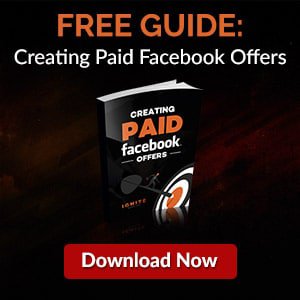

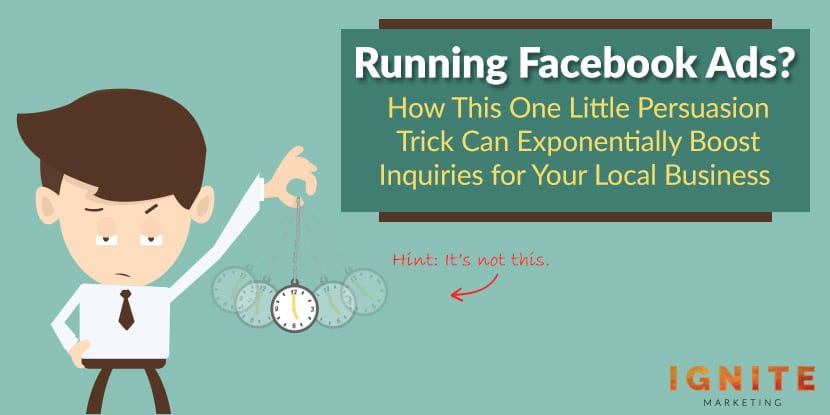
Pop quiz: what do these ads have in common?
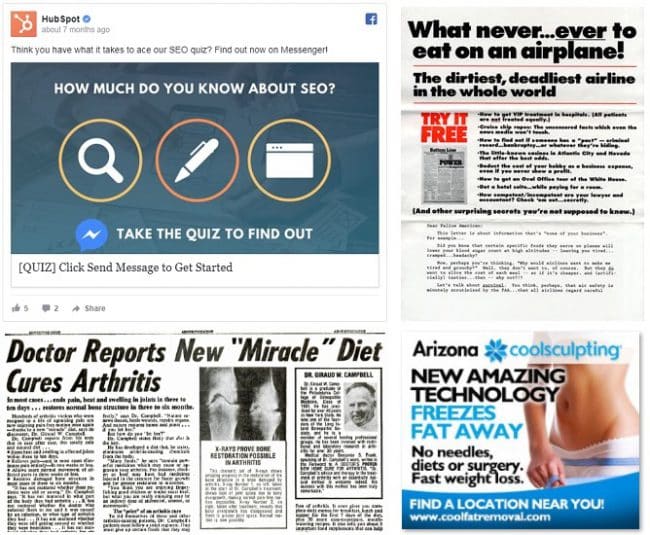 [Hint: it’s the same persuasion tactic that got you to click on this post.]
[Hint: it’s the same persuasion tactic that got you to click on this post.]
In fact, it’s one of the most powerful copywriting techniques you can use to increase click-through rates, signups, and inquiries.
And it’s the reason you’re still reading.
The answer?
It’s the appeal to your innate sense of curiosity.
Yeah, you really wanted to know what that one little persuasion trick was, didn’t you?
Would you have been as interested if the headline read, Curiosity Can Exponentially Boost Inquiries for your Local Business?
In our increasingly noisy and cutthroat world where thousands of marketing messages have to vie for attention every second or die, the chances are you might not have been as eager to click.
So, let’s explore this concept further and dig into how you can use curiosity to build powerful Facebook Ad campaigns for your local business.
Definition:
 In my previous post, I wrote about how Josh Weltman, co-producer of Mad Men and author of Seducing Strangers (How to Get People to Buy What You’re Selling), divided ad campaigns into four categories. The first category he identifies is introductory ads.
In my previous post, I wrote about how Josh Weltman, co-producer of Mad Men and author of Seducing Strangers (How to Get People to Buy What You’re Selling), divided ad campaigns into four categories. The first category he identifies is introductory ads.
Introductory ads tap into George Lowenstein’s curiosity gap theory by leaving out a crucial piece of information that makes us want to learn more. When we’re faced with unresolved, incomplete, or ambiguous messaging, we have a natural desire to fill in the unknown—to find out the end of the story, to complete the task, to discover the answer. And so, in the context of the ads presented above, one might ask:
Our desire to know the answers motivates us to complete the action that will help us achieve the goal of filling in the gap.
Think about it…
Why do you endure ad breaks when you’re watching your favorite TV show? Why do you tune in week after week?

We hate cliffhangers. They drive us crazy because we’re hardwired to want a conclusion. When something disrupts our normal processing of information and arouses curiosity, we tend to experience intrusive thoughts about the outcome until we know what that outcome is. During this time, the chemistry in our brain changes, improving our ability to retain information and learn.
In Gestalt psychology, this is known as the Zeigarnik effect. Stated simply, people remember interrupted or incomplete tasks better than completed tasks. As a result, we don’t feel satisfied until we have closure. For marketers, this phenomenon has proven to increase our ability to persuade.
In introductory ads, copywriters often use the words “new” and “improved” to signify that the product or service has never been seen before or that something about an existing product or service has changed to make it better. However, they don’t tell you what it is until they’ve grabbed your attention and hooked you—something that’s often achieved with headline copy. They purposely omit something so that you can do nothing else but assuage your curiosity by reading the rest of the copy, clicking through to the next page, or completing another task to find the answer.
Often, the process happens so quickly and subtly, we’re not consciously aware of it.
Weltman further explains this as “a tantalizing cocktail of brain chemicals.”
First, the ad triggers a release of adrenaline by causing disruption, confusion, or agitation. Your heart and respiratory rates increase, your blood vessels constrict, and you have a heightened sense of excitement. Next, your brain starts engaging the reward system, releasing a hit of dopamine as you figure out the answer through explanation, confirmation, or comfort.
The way to get that explanation, confirmation, or comfort?
Well, that depends on the campaign’s call to action.
As a local business owner, you want people to reach out to you or inquire about your products and services in one way or another. Creating campaigns that spark curiosity is a highly effective way of encouraging this reward-motivated behavior where information is the prize.
The only question now is…
Let’s get one thing straight before moving forward: when I talk about campaigns that build curiosity, I’m not referring to clickbait content or copy created by the likes of BuzzFeed and Upworthy. In fact, Facebook hates clickbait and actively throttles reach and denies ad permission. So, there will be none of that “This Dad Set Up a Secret Nanny Cam in His Home and What Happens Next Will Shock You!”
People will go to great lengths to obtain the information that fills the curiosity gap and as a result you gain their compliance. It’s crucial to respect and honor that because wielding this powerful persuasion tactic in a deceptive or manipulative way can backfire on your business big time.
With that said, let’s jump into it…
Knowing why people look for answers is one thing. Knowing what answers they’re looking for is a whole new ball game—and the key to your successful use of the curiosity gap.
There’s a reason Google processes nearly 67,000 searches every second. The search giant feeds our curiosity. However, you’re targeting only a teeny tiny fraction of internet users. Therefore, it’s crucial to know your audience and what resonates with them.
What’s their problem? What’s their need? What relevant topics interest them? What relevant questions are they asking? Where are they in your marketing funnel?
While some people might be completely unaware of their problem or need, others not only know what the solution is but they also know your business and have been patrons at one point. It’s crucial to identify where people are on this scale so that you can create the right offer and campaign message for where they are.
Where do you find the right data for the right idea?
Dive into your Google Analytics to see which of your website pages and blog posts are the most popular. Check your social media insights to uncover your most engaging posts. Poll your audience to find out what they want to learn about next. Monitor popular search trends in your industry. You can then use this information to create offers that make the most sense for your business and your audience.
Uncovering the right idea for this type of campaign boils down to finding a delicate balance between what your audience knows, what they want to know, and what you want them to know. Begin with a brainstorming session and then validate your ideas through your research.
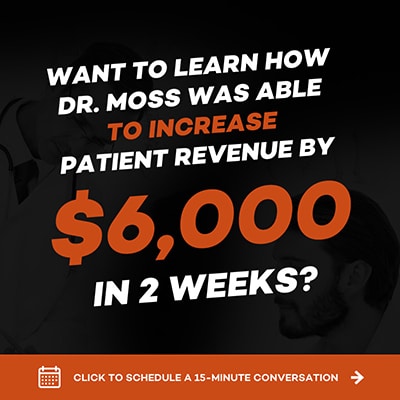 Step 2: Adjust Your Metrics and Set Goals Accordingly
Step 2: Adjust Your Metrics and Set Goals AccordinglyWith other campaign types, you might measure engagement, traffic, views, or any one of the other several hundred metrics you can track. With a campaign designed around curiosity, you want to measure key performance indicators that tell you your message aroused curiosity and made people what to know more. Depending on the nature of your campaign, this could include website hits, store visits, incoming phone calls, sign ups, new leads, downloads, or a number of other actions you want your target audience to take.
It’s tempting to simply look at click-through rates, but it’s not a great success metric in this situation. You need conversions, which means you need to look beyond the surface and be specific.
What metrics matter most to your business? And what’s your goal for each one?
Do you want 2,000 downloads, 500 new leads, 100 bookings, 200 phone inquiries, 400 visitors to your store, 150 repeat customers, or 200 monthly subscriptions?
Without question, you want an increase in sales. But it’s important to understand how effective curiosity was in getting you there.
Here’s your chance to get creative. Using your research, ideas, and metrics, consider how you can develop curiosity-driven campaigns that motivate action and support your goals.
Start by deciding what piece of information you’ll omit or how you’ll create mystery around your offering. If you’re releasing a new product or service, identify how it’s different from similar products and services in the market and then use that differentiation to create a curiosity gap.
Let’s take a look at a few examples to inspire you.

Leveraging the ever-popular coupon, California Pizza Kitchen handed customers a Thank You card with their receipt. Each card contained a prize, ranging from a free item off the menu to monetary vouchers of different values. How did this casual dining restaurant chain create curiosity and drive additional sales?
First, customers weren’t allowed to open their card to reveal their prize until they returned for their next visit. Even then, only a manager could open the card in order for the coupon to be deemed valid. Second, every customer who received a card was promised something of value. Since the card remained closed, they were teased with the possibilities.
Now imagine this concept in the context of a Facebook Ad campaign where the value of the item (monetary or otherwise) is only revealed after the lead signs up to your list. Who wouldn’t want a surprise coupon waiting in their inbox?
 It may only contain a single line of copy, but this ad nails curiosity.
It may only contain a single line of copy, but this ad nails curiosity.
What makes Simba’s mattress the most advanced mattress in the world? Do they use special technology? Is it something guaranteed to help me sleep better? Facebook users have to consume the rest of the visually-rich and compelling carousel content to find out, making the ad an engaging and immersive experience. The benefits become clear, the features become clear, and the CTA and free trial offer tells you exactly what to do. But you wouldn’t necessarily have made it to the end of that carousel if there wasn’t curiosity driving your actions.
 Did you ever think that a meal kit delivery service could be easier on your wallet than shopping at your local grocery store?
Did you ever think that a meal kit delivery service could be easier on your wallet than shopping at your local grocery store?
For most of us, the possibility is in complete contrast to what we’d normally think, so clicking on the ad to either confirm or contradict our suspicion is something we simply must do. The ad does a great job of not only grabbing attention and piquing curiosity but also offering value, especially to those who might need to tighten their purse strings.
 In this example, Matt Davies Team pairs an intriguing visual with curiosity-inducing copy. Notice how the image is highly relevant to the business’s local target audience. The dollar values not only provide context and credibility, but they also make the offer hard to ignore even if you’re not planning to sell right now—and hey, once you’re in their funnel, they can promote their content and services to you as long as you’re part of their list.
In this example, Matt Davies Team pairs an intriguing visual with curiosity-inducing copy. Notice how the image is highly relevant to the business’s local target audience. The dollar values not only provide context and credibility, but they also make the offer hard to ignore even if you’re not planning to sell right now—and hey, once you’re in their funnel, they can promote their content and services to you as long as you’re part of their list.

A free guide serves as a great lead magnet, but it’s the positioning of this offer that makes it especially compelling. Any animal lover seeing this ad from the Central California SPCA would want to know all the risks extreme heat poses to their pet. The phrasing of the first line suggests there may be more dangers than the obvious—more than what you might know. The ad is eye-catching, the offer is timely, and the intriguing copy pulls on our animal-loving heartstrings.
Ultimately, the key to creating a great curiosity-inducing offer lies in your ability to provide value while leaving out just enough information to make it interesting. When customers are teased, the draw to have their curiosity satisfied can prove to be irresistible.
On Facebook, images are perhaps the most crucial element of your ad. While you’re essentially looking to create the “Goldilocks” of ads (i.e. everything should be just right), the image could be your one chance to stand out and be seen.
At any given time, every Facebook user has several thousand pieces of content vying for a position in their News Feed. If your ad makes it, you need it to capture attention. Using eye-catching and contrasting colors can easily achieve this, but you also want to play off the emotions your copy evokes.
Consider the images in the ad examples above. They make us take notice, they reflect the business’s hook, and they appeal to the sense of curiosity in us. Your creative should do the same, making your audience ask questions like “What’s going on here?”
Remember, you want to create a disruption in the minds of your target consumers. Images that are offbeat, bizarre, funny, interesting, and go against the grain of what we normally see in the News Feed are likely to gain attention.
Ad Agency Publicist did an awesome job with CVC’s ad creatives.
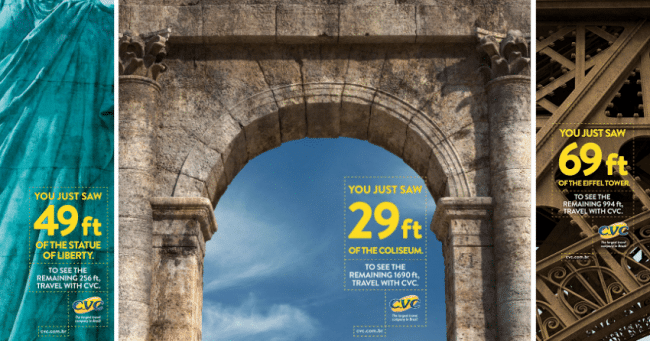
They effectively conjured up curiosity and a desire to travel while emphasizing the sheer magnitude of famous monuments. Using partial images like this can be a great way to ignite curiosity and make people want to take action to see the rest.
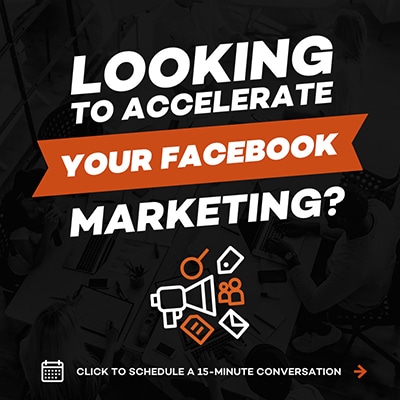 Next you want to write your copy. During this step, you can employ a number of effective techniques for crafting persuasive messages that catch the attention of your audience while tapping into the power of the curiosity gap. Here are some of the most effective tips to get you started:
Next you want to write your copy. During this step, you can employ a number of effective techniques for crafting persuasive messages that catch the attention of your audience while tapping into the power of the curiosity gap. Here are some of the most effective tips to get you started:
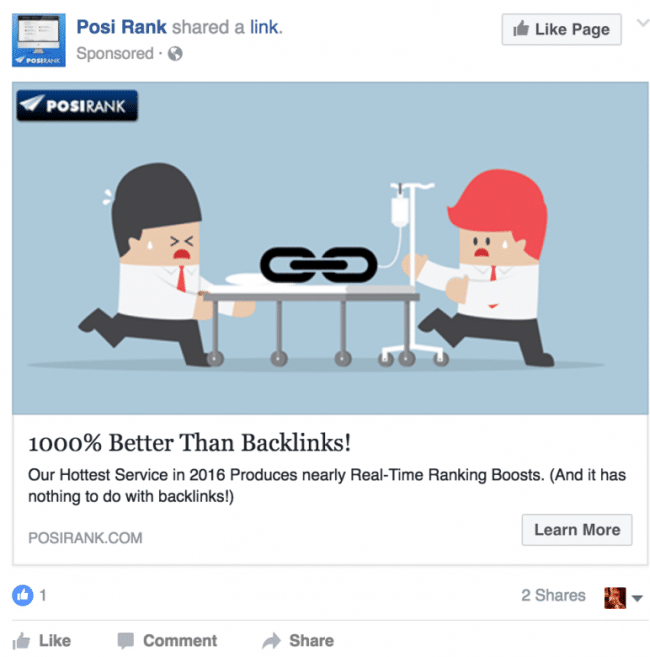 The secret to mastering the art of copy that pique’s your audience’s curiosity without falling into BuzzFeed and Upworthy territory is practice. It isn’t always easy, but if you evaluate what others are doing in the marketplace and how their curiosity-based ads and teasers make you feel, you’ll soon get the hang of it.
The secret to mastering the art of copy that pique’s your audience’s curiosity without falling into BuzzFeed and Upworthy territory is practice. It isn’t always easy, but if you evaluate what others are doing in the marketplace and how their curiosity-based ads and teasers make you feel, you’ll soon get the hang of it.
For a Facebook Ad campaign to produce a respectable return on ad spend, you have to have the right pieces of your funnel in place. This includes your landing page, thank you page, email sequence, follow-up text messages, etc. You also need to make sure you have your audience targeting down to a fine art and that you have tracking in place.
Whether you’re setting up a campaign for the first time or you simply want a checklist, grab a free copy of my guide on creating paid Facebook offers by clicking the image below. I cover everything you need to create a compelling campaign and optimize it for conversions.

Unfortunately, there is a dark side to curiosity. Browse the Internet for a few minutes and you’ll quickly discover egregious abuses of the curiosity gap are rampant. In addition, using this persuasive trick the wrong way can also produce curiosity clicks that drive up your ad spend but don’t result in conversions. To ensure your campaign doesn’t flop, you should pay attention to the following caveats.
1. Deliver on your promise.
Do not disappoint genuine customers by using curiosity for the sake of grabbing attention. Besides failing to convert anyone, you’re also guaranteed to lose credibility. Your use of curiosity must correlate with your product or service offerings.
When people feel duped, they don’t buy. Content that delivers makes people feel satisfied, generally leading to good feelings towards you and your business. Always consider how the reader will feel once they click through to your content—that’s the difference between the curiosity gap and clickbait.
2. Target the right people and reveal the right information.
I cannot stress enough the importance of knowing your audience and applying ad targeting correctly. Failing to hyper target, as well as holding back the wrong information, can be detrimental to the success of your campaign. Clicks without conversions mean nothing, so be strategic in your campaign development and turn off campaigns that aren’t working.
The great thing about this persuasion trick is that the curiosity gap can be used in almost everything you do. From email campaigns and regular social media posts to blog posts and in-store promotions, the sky is the limit.
As I sign off, I’ll leave you with this:

Have you been using curiosity in your marketing efforts? How will you use the curiosity gap moving forward? Share your thoughts, insights, and clickbait tales with us in the comment section below.
